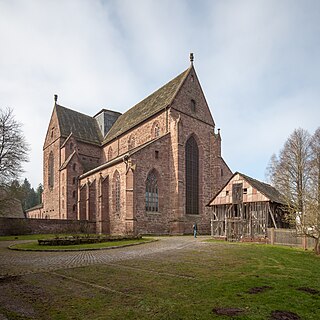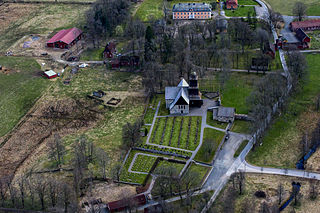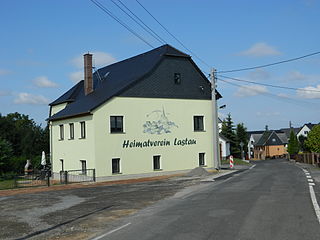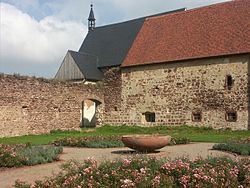
Maulbronn Monastery is a former Cistercian abbey and ecclesiastical state in the Holy Roman Empire located at Maulbronn, Baden-Württemberg. The monastery complex, one of the best-preserved in Europe, was named a UNESCO World Heritage Site in 1993.
Pforta, or Schulpforta, is a school located in Pforta monastery, a former Cistercian monastery (1137–1540), near Naumburg on the Saale River in the German state of Saxony-Anhalt.

Aldersbach Abbey is a former Cistercian monastery in the community of Aldersbach in the district of Passau in the valley of the Vils, Lower Bavaria, Germany.

Dobrilugk Abbey was a Cistercian monastery in Lower Lusatia in the territory of the present town of Doberlug-Kirchhain, Brandenburg, Germany.

Walkenried Abbey was a Cistercian abbey located in the village of Walkenried in Lower Saxony, Germany. Founded in 1127 on the southern rim of the Harz mountain range, the remnants of the monastic complex since 2010 are part of the Upper Harz Water Regale World Heritage Site.

Salem Abbey was a very prominent Cistercian monastery in Salem in the district of Bodensee about ten miles from Konstanz, Baden-Württemberg, Germany. The buildings are now owned by the State of Baden-Württemberg and are open for tours as the Salem Monastery and Palace.

Sittichenbach Abbey, sometimes also known as Sichem Abbey, is a Cistercian monastery in Sittichenbach, now part of Osterhausen near Eisleben in the Mansfeld-Südharz district, Saxony-Anhalt, Germany.

Heilsbronn Abbey was a Cistercian monastery at Heilsbronn in the district of Ansbach in Middle Franconia, Bavaria, Germany. It was part of the Diocese of Eichstätt.

Langheim Abbey was a well-known Cistercian monastery in Klosterlangheim, part of the town of Lichtenfels in Upper Franconia, Bavaria, Germany, in the Bishopric of Bamberg.

Bebenhausen Abbey is a former Cistercian monastery complex located in Bebenhausen, Baden-Württemberg, Germany. The complex is also the location of Bebenhausen Palace, a hunting retreat created and maintained by two Kings of Württemberg. The complex was named a historic monument in 1974.

Amelungsborn Abbey, also Amelunxborn Abbey, is a Lutheran monastery in Germany. It is located near Negenborn and Stadtoldendorf, in the Landkreis of Holzminden in the Weserbergland. It was the second oldest Cistercian foundation in Lower Saxony, Germany, after Walkenried Abbey. It survived the Reformation by becoming Lutheran, and with Loccum Abbey, also previously Cistercian, is one of the only two Lutheran monasteries in Germany with an uninterrupted tradition. The abbey church, St. Mary's, is also the parish church of the abbey's former estate villages Negenborn and Holenberg.

Nydala Abbey was a Cistercian monastery in the province of Småland, Sweden, near the lake Rusken. Although the abbey ceased to operate in the 16th century, its church was renovated and converted into a Protestant church during the 17th century and is still in use. The church belongs to the Church of Sweden and is part of the Diocese of Växjö.
Michaelstein Abbey is a former Cistercian monastery, now the home of the Stiftung Kloster Michaelstein - Musikinstitut für Aufführungspraxis, near the town of Blankenburg in the Harz in Sachsen-Anhalt, Germany.

Ås Abbey was a Cistercian monastery situated near the present village of Åskloster about 14 km north of Varberg, in Varberg Municipality. It was located near the mouth of the River Viskan into the Kattegat in Halland, formerly part of Denmark but now in Sweden
The Borsdorf–Coswig railway is a mainline railway in the German state of Saxony, originally built and operated by the Leipzig-Dresden Railway Company. It runs mostly along the Freiberger Mulde from Borsdorf via Döbeln and Meissen to Coswig near Dresden. It is part of a long-distance connection from Leipzig to Dresden, but is now used for local traffic only.

Lastau is a village in Landkreis Leipzig, Saxony, Germany with approx. 222 inhabitants (2012). On 1 January 1994 it was incorporated into the town Colditz.

Mildenstein Castle, in German Burg Mildenstein, also called Schloss Leisnig, is located in Leisnig in Landkreis Mittelsachsen, Saxony, Germany. It is a property of the Free State of Saxony and is administrated by the company State Palaces, Castles and Gardens of Saxony.

Gymnasium St. Augustine in Grimma (Gymnasium St. Augustin zu Grimma, historically known as Landes- und Fürstenschule Grimma is the only regular gymnasium offering boarding in Saxony. It is heavily steeped in tradition as one of the foremost schools in the country. Founded in 1550 as one of the three Fürstenschulen in Saxony, it has prepared young people for university studies since then.

The Pforta monastery is a former Cistercian monastery located near Naumburg in Saxony-Anhalt, Germany. It was established in the 1130s and prospered in the Middle Ages. In the course of the Reformation the monastery was disbanded in 1540. Today the buildings are used by the school Landesschule Pforta. The site is located on the tourist route Romanesque Road and has been nominated by Germany for inclusion in the UNESCO list of World Heritage Sites.


























